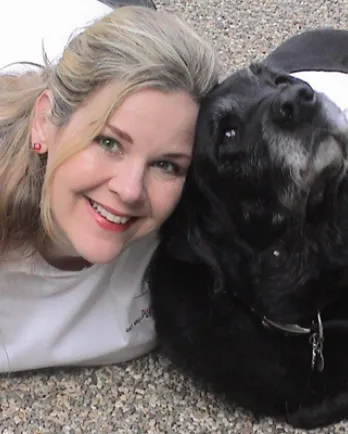Getting to Know Your Senior Dog from Head-to-Tail
Our dogs can't tell us when something is wrong. By getting to know your furry best friend from head-to-tail, you can more readily detect a problem early and intervene. In this webinar, Denise Fleck, The Pet Safety Crusader and Grey Muzzle's Board President, provides step-by-step instructions to perform an at-home examination of your dog.
Checking Your Senior Dog’s Vital Signs
Knowing what’s normal for your dog is critical to identifying problems that may require a trip to the veterinarian. Learn what the normal respiration and heart rates are for dogs and what a normal body temperature range is. Denise demonstrates how to safely take your dog’s temperature, assess level of hydration, check circulation, and gauge body condition.
Conducting a Thorough Assessment of Your Senior Dog
Starting with the ears, Denise walks viewers through what they should look for in their dog’s ears and how to keep ears clean. Moving on to the eyes, she demonstrates an eye tracking test, and then shares tips for checking your dog’s muzzle and snout.
The importance of dental health cannot be overstated. Viewers learn how to (carefully!) check your furry friend’s mouth. Gums should be a healthy pink (except for chows or black Labs)with no odor coming from the mouth. An unpleasant scent could indicate gum disease, tooth decay, or gastrointestinal problems. Sweetness or an acetone-like scent could signal diabetes, but only your veterinarian knows for sure.
Think of the Rest as a Doggie Massage
The rest of the head-to-tail exam is like a gentle massage, looking and feeling for things that don’t belong on your dog (e.g., bumps, tenderness, wounds, parasites, burrs, foxtails). Denise shares tips on what to look for on your senior dog’s paws and legs, abdomen, and skin.
The Tail End
Denise recommends concluding your head-to-tail check-up with a game of ball, belly rubs, or a healthy treat. Between checks, it’s important to take note of your dog’s habits: How often must the water bowl be refilled and how frequently does your senior guy or gal need to answer nature’s call? Does your doggie lean to one side as he walks or sits, moan or labor getting up or down? Anything unusual could be a sign that your best pal is suffering in silence.
Finally, know the shortest route to your Animal Emergency Hospital and regularly get down on all fours to keep dangers out of your dog’s reach. It’s always a smart idea to stay prepared to handle what life throws your way by keeping your pet first aid kit up-to-date and refreshing pet first aid skills frequently.
What Viewers Are Saying
- “This webinar was extremely helpful as we have only recently adopted Charlie, a nine-year-old Lab and beagle mix. I feel I now have enough information to monitor my buddy's general health and better communicate with our veterinarian.”
- “The content was thorough, easy to understand, and so helpful. I loved the stuffed dog being used as an example.”
- “Very practical tips that I could implement easily.”
About the Presenter
Denise Fleck is an award-winning author and animal care instructor who developed the curriculum for her Pet First-Aid & CPCR and Pet Disaster Preparedness Classes after training with dozens of schools and organizations, practicing, attending seminars and practicing some more. Known as The Pet Safety Crusader™, Denise has personally taught more than 30,000 humans animal life-saving skills and has appeared on Animal Planet's Groomer Has It and Pit Boss, A&E's Kirstie Alley's Big Life, CBS-TV's The Doctors, CNN Headline News, PBS-TV's Lassie's Pet Vet and KTLA Los Angeles as well as on radio and in magazines. She is President of the Board of the Grey Muzzle Organization as her soft spot lies with caring for senior pets.





